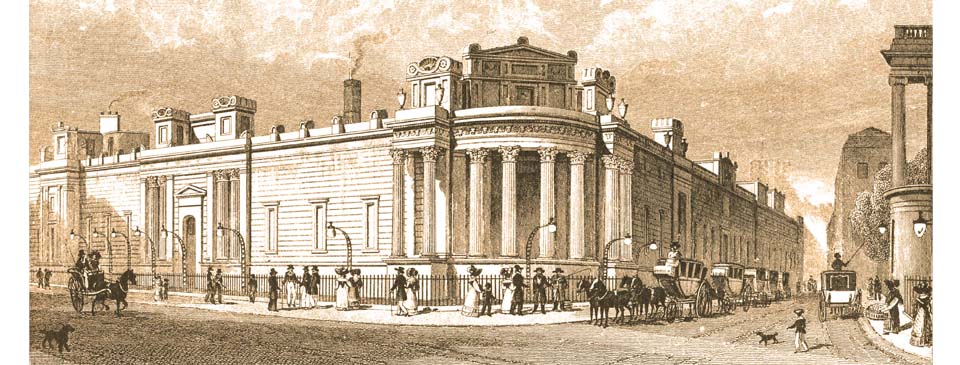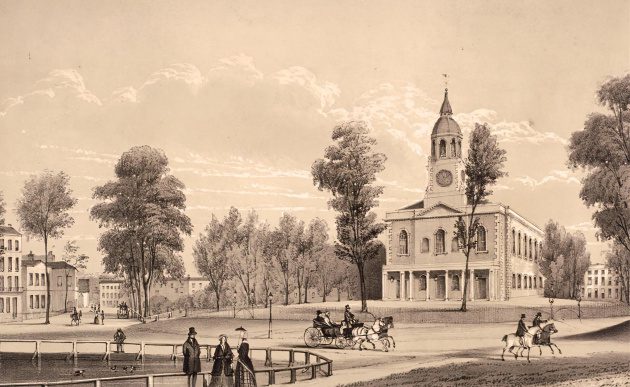In brief – London in the Age of Improvement

The new Bank of England. It had originally opened on the current site in Threadneedle Street in 1734, at what was then the house and garden of its first governor, Sir John Houblon. It was rebuilt between 1788 and 1833 according to the design of Sir John Soane, shown in this picture by Thomas H. Shepherd from 1827. Soane’s building was largely replaced in the 1920s.
Spencer Perceval is the only British Prime Minister in history to have ever been assassinated. He was shot in May 1812 by a man with a grudge against the government while on his way to a meeting in the House of Commons. Several radical groups formed in the early 19th century, intent on overthrowing the government. One group known as the Spenceans planned to assassinate several members of the government in Grosvenor Square in February 1820. They rented a stable in nearby Cato Street as their base but were arrested there by police who had infiltrated their operation.
During the 18th century gentlemen often met to socialize or undertake business in coffee-houses, with those of a particular interest meeting at certain venues. It was in coffee houses that stocks such as those of the East India Company and Bank of England were traded until the establishment of London’s first dedicated stock exchange building in 1802 at Capel Court.
Drinking and dining clubs of like-minded men were formed, usually gathering regularly in a private room attached to a tavern. From this idea, gentlemen’s clubs were founded with their own separate premises where members could come and go at any time and even use the place as their London home. A number of such clubs were formed in the early part of the 19th century, mostly located around Pall Mall, including the Travellers’, the United Services, the University, the Athenaeum, and the Reform Club.
Until the early 19th century the only art collection accessible to a limited section of the public was that at the Foundling Hospital. England’s first public art gallery was created when a London-based collector bequeathed his collection to Dulwich College. Sir John Soane designed the building, in which the collection remains at Dulwich Village. Yet there was still no national art collection until George IV persuaded the government to spend £57,000 to purchase thirty-eight paintings from the collection of the financier John Julius Angerstein, including works by Raphael and Rembrandt. The old Royal Mews near Charing Cross was selected as the site for a gallery in which to house the collection and the Royal Academy. A new building was created, and the National Gallery was completed in 1838.
The British Museum was housed in Old Montague House at Bloomsbury but the collection was growing, with antiquities captured from the French and the purchase of the Parthenon marbles from Lord Elgin. From 1823 the architect Sir Robert Smirke enlarged the building over a period of thirty years, basing his design on a Grecian temple.
As knowledge and educational needs increased, two colleges were founded in London at the beginning of the 19th century. University College was opened in Gower Street as a Utilitarian, religiously non-sectarian establishment in 1826. A group of Tory Anglicans founded King’s College in 1828 and were gifted land by the government on which to build beside Somerset House, between the Strand and the Thames.
The Bethlehem Hospital for the insane moved from Moorfields, where it had been located since the late 17th century, to a new site at Lambeth in 1811. It remained there until the mid-20th century and the building later became the Imperial War Museum.
Two zoos opened in London in quick succession. The one at Regent’s Park began in 1828 and is still in operation today. It was followed three years later by the Surrey Zoological Gardens at Kennington, which closed in 1877.
The Oxford and Cambridge boat race began in 1829 when two former friends from Harrow school, by then each attending Oxford and Cambridge universities, set up a rowing challenge. The first was held at Henley but moved to London thereafter.
Slavery, from which London had benefitted economically during the previous century, was one of the issues of the 1806 general election, which saw a number of new abolitionist MPs enter the Commons. That year William Wilberforce published his book A Letter on the Abolition of the Slave Trade and the tide began to turn against the trade. Slavery was eventually abolished in stages during the 1830s.
The Age of Improvement, during which London had undergone major changes, was due in part to the extravagance of the Prince Regent, yet as George IV he largely retreated from public life. Following his death in 1830 he was succeeded by his younger brother, William, a frugal man who was happy to walk unguarded through the streets of London.
< Go back to In Brief: London in the Georgian Golden Age or forward to In Brief: London during the mid-19th century >


